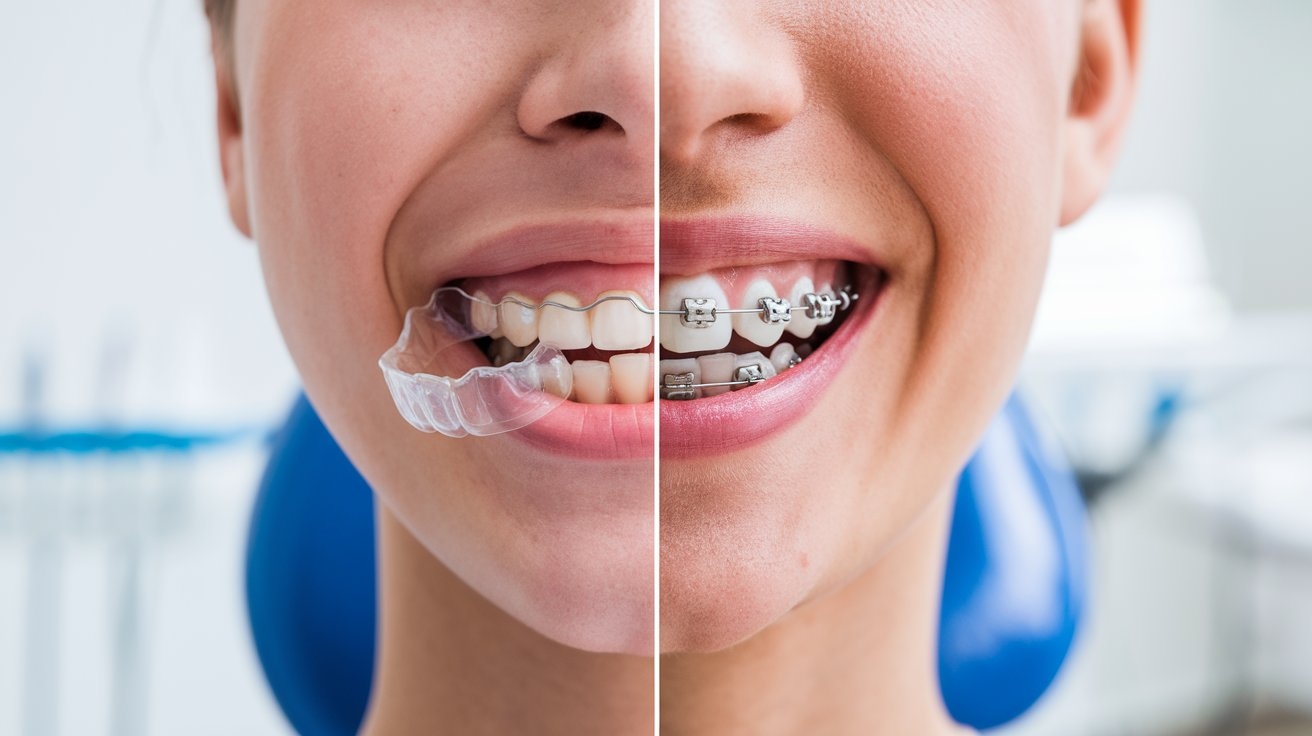What Is Better: Invisalign or Braces?

In deciding between Invisalign and braces , it's essential to consider factors like effectiveness, aesthetics, comfort, and cost. Both treatments have advantages and disadvantages, and the right choice depends on individual dental needs and preferences. This article explores both options to help you make an informed decision, whether you're considering North Kellyville Dental or other dental services.
What Are Invisalign and Braces?
Invisalign
Invisalign is a modern orthodontic treatment using clear, custom-fitted aligners to shift teeth into place. The aligners are made from a transparent plastic material, making them a popular choice for those seeking a more discreet treatment.
Braces
Braces involve metal brackets bonded to each tooth and connected by wires. This traditional method applies consistent pressure to gradually realign teeth. Braces have evolved, with options for ceramic and lingual braces offering less visible choices.
How Do Invisalign and Braces Compare in Key Areas?
| Criteria | Invisalign | Braces |
|---|---|---|
| Aesthetics | Nearly invisible, ideal for professional settings | Visible but available in ceramic for less visibility |
| Effectiveness | Effective for mild to moderate cases | Best for complex cases, especially severe misalignments |
| Comfort | Removable, fewer mouth sores | Fixed; may cause initial discomfort and mouth sores |
| Hygiene | Easy to clean as removable | Difficult; brushing and flossing require extra effort |
| Dietary Limits | No food restrictions | Certain foods can damage braces (e.g., hard/sticky items) |
| Cost | Typically higher, ranging from $3,500 - $8,000 | Generally more affordable, $2,500 - $6,000 |
| Duration | 12-18 months on average | 18-24 months, depending on complexity |
Aesthetic Differences: Which Looks Better?
For those who prioritize appearance, Invisalign offers a significant advantage. The clear aligners are practically invisible, making them ideal for adults and teens who prefer a subtle orthodontic solution. Braces, even in ceramic form, are noticeable, though ceramic brackets are less visible than traditional metal ones.
Treatment Effectiveness: How Well Do They Work?
- Invisalign:
- Best for mild to moderate issues, such as minor crowding, gaps, and bite corrections.
- May not suit complex dental issues like severe overbites or twisted teeth.
- Braces:
- More versatile and effective for complex issues like severe misalignments and bite problems.
- Continuous pressure helps treat a broader range of orthodontic problems.
Comfort and Convenience: Which Feels Better?
- Invisalign:
- Comfort: Smooth plastic aligners reduce the risk of mouth sores.
- Convenience: Removable aligners simplify eating and cleaning.
- Braces:
- Comfort: Metal brackets can irritate the inside of the mouth, though pain typically subsides.
- Convenience: Fixed braces may require more frequent orthodontic visits for adjustments.
Pro Tip:
North Kellyville Dental advises patients on choosing the right treatment for maximum comfort and results.
How Do Invisalign and Braces Differ in Hygiene and Maintenance?
-
Invisalign:
- Cleaning: Simple to clean as they’re removable.
- Maintenance: Aligners need daily cleaning and safe storage.
-
Braces:
- Cleaning : Challenging due to fixed brackets and wires.
- Maintenance : Requires special brushes and regular dental visits for adjustments.
Dietary Restrictions: What Can You Eat?
- Invisalign :
- No Restrictions : Removable, so you can enjoy all foods.
- Braces :
- Limited Options : Avoid hard, sticky foods to prevent damage.
Cost Comparison: How Much Does Each Option Cost?
-
Invisalign :
- Costs range from $3,500 to $8,000 .
- Insurance may partially cover expenses, but higher initial costs are common.
-
Braces :
- Generally more affordable, with a price range of $2,500 to $6,000 .
- More likely to be fully covered by insurance.
Treatment Duration: How Long Will It Take?
-
Invisalign :
- Average treatment time is 12-18 months .
- Aligners require consistent wear, typically 20-22 hours per day .
-
Braces :
- Treatment can last from 18 to 24 months , depending on complexity.
- Progress is slower, but braces are effective for a broader range of issues.
Maintenance and Follow-Up: What Does Each Option Require?
-
Invisalign :
- Requires discipline, as aligners must be worn consistently .
- Typically needs fewer in-person visits, as progress can be monitored remotely.
-
Braces :
- Needs regular adjustments , typically every 4-6 weeks.
- More frequent visits ensure effective progress but can be time-consuming.
Specific Scenarios: When to Choose Invisalign or Braces
- For Mild to Moderate Alignment Issues :
- Invisalign is often preferred for minor corrections where aesthetics are a top priority.
- For Severe Alignment and Bite Issues :
- Braces are typically more effective for complex cases, such as severe crowding or overbites.
- For Busy Schedules :
- Invisalign may suit individuals who want flexibility in visits and hygiene.
Pros and Cons Summary: Invisalign vs. Braces
| Feature | Invisalign | Braces |
|---|---|---|
| Pros | Almost invisible, removable, comfortable | Effective for complex cases, generally affordable |
| Cons | Higher cost, limited for complex cases | Visible, potential discomfort |
FAQs
Is Invisalign Suitable for All Ages?
Invisalign is generally suitable for older teens and adults with developed jaws, making it an ideal choice for those seeking discreet treatment.
Can I Switch from Braces to Invisalign?
Switching is possible if your dentist approves , particularly for minor corrections after using braces. This option varies by individual case.
Does Invisalign Cause Pain Like Braces?
Invisalign's smooth aligners cause less discomfort than braces. However, some pain can occur during initial wear due to tooth movement.
Are Lingual Braces a Good Compromise?
Lingual braces are affixed behind the teeth, offering a compromise between visibility and effectiveness. They work like traditional braces but are less noticeable.
Final Considerations: Invisalign or Braces?
Choose Invisalign if:
- Aesthetic concerns are a priority.
- You have mild to moderate alignment issues.
- Flexibility in daily routines and diet matters.
Opt for Braces if:
- Your case is complex, involving severe misalignments.
- Cost-effectiveness is crucial.
- You're comfortable with the appearance of braces.
Invisalign and braces each provide unique benefits, and your final decision should reflect your personal needs, aesthetic preferences, and dental health requirements. Whether opting for Invisalign or braces , consulting with an experienced provider like North Kellyville Dental can ensure you make the best choice for your smile.
- Industry
- Art
- Causes
- Crafts
- Dance
- Drinks
- Film
- Fitness
- Food
- Jogos
- Gardening
- Health
- Início
- Literature
- Music
- Networking
- Outro
- Party
- Religion
- Shopping
- Sports
- Theater
- Wellness
- News


